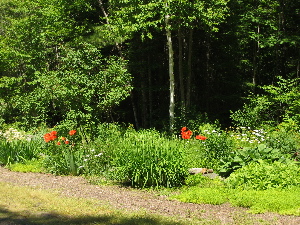I had a question about separating Bearded Iris in the last posting. I thought I’d do an entire post on Iris in case others of you had questions as well. So, here we go!
Bearded Iris are among the most delightful perennials I can imagine! They are beautiful and relatively easy to manage.
As you think about where to place them in your garden, think
“SUN”. They love to be in full sun. In warmer climates they appreciate a bit of shade, but the last time I checked the North Country, we didn’t fall into that category!
The rhizomes are healthiest if they are exposed to sunshine and air. Whenever I transplant Iris, I separate them and lay those rhizomes on a sunny rock for a day or two to completely dry out before replanting them. They seem to really appreciate the sunbath.
When you put them into the ground, leave them a bit exposed. If your Iris do not bloom, check to see if you can see the surface of the rhizomes, if you can’t see them, scrape off the dirt and I can almost guarantee you will have better bloom.
In our area, Iris should be separated after they bloom. Depending on the variety and your own climate, which could be either July or August. The reason for this could not be easier.
ENJOY the flowers, THEN dig them up and separate them as soon after flowering as is convenient. Remember they need to be established before frost. I would suggest that you finish up with this chore before mid-September.
They will eventually get crowded and should be separated every 3-4 years. So, take your gardening fork and dig up the whole clump.
Check EVERY rhizome for softness or rot. If there is any rot, ruthlessly cut it out, and discard it in the GARBAGE, NOT THE COMPOST. You don’t want to put borer’s or disease into your compost!Separate all the rhizomes, discarding the old and saving the new and healthy ones. Lay them on that sunny rock and let them dry out. While you’re waiting for that to happen, begin to prepare the hole(s) for replanting.
Dig a hole larger than the spread of the roots.
In the center of the hole make a kind of hill of soil, so you can put the rhizome on top of it and drape the roots out and down the sides of the little hill. Always pack the soil firmly around the roots after planting and water thoroughly. They can be planted between 10 and 24 inches from each other. The closer they are planted, the sooner you’ll have to go through this exercise again. However, close planting will give a great display. I guess it boils down to how much time you want to devote to separating Iris!
As far as the soil is concerned,
Iris like their soil neutral and well drained. However, when you plant them you can add bone meal, or super phosphate directly into the soil. Some people wait until the next year to add this. It’s pretty much up to you. After they are established any 6-10-10 fertilizer will work well.
Generally the iris borer is the biggest iris pest there is! You’ll see signs of borers beginning in May or June. You’ll see little holes in the leaves that will become larger as the borers grow and get hungrier.
In order to keep these guys at bay, trim off any dead leaves in the early spring by tearing them right down to the rhizome. After the Iris have bloomed, you should cut off the leaves in the shape of a fan a couple of inches above the rhizome. This tends to help a good deal. Again, if there’s any sign of borers, put the leaves in the garbage, NOT the compost!
Be sure to keep these newly planted Iris gently and deeply watered. Once they are established their need for water is minimal.
Any other questions about Iris?




